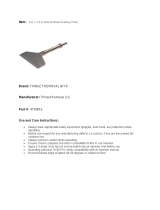
9
Controlling Your System
Warmup only recommends listed or c-UL Certified programmable thermostats designed for use
with underfloor heating to control the Warmup mat. When using multiple heating mats you can
connect them in parallel to the same thermostat. Check with your installer or call Warmup for
circuit sizes and maximum loads.
The thermostats come with a 9’ sensor cable to detect the temperature under the floor finish.
The end of the probe wire contains a capped sensor that should be evenly centered between
two heating cables at least 12” into the heated area. At no time should the probe wire cross
the heating cable.
If you have more than one heating mat, all the lead wires need to be connected in parallel to
the thermostat. For convenience, it may be easier to run multiple lead wires to a junction box
and then take a single wire (which has the appropriate rating) from the junction box to the
thermostat.
NOTE: 240V wires are Red and Black. 120V wires are Yellow and Black. Connect ground wires
to the power source ground.
The total Amp load of the heating mat(s) must not exceed the thermostat’s Amp limit or the
Amperage rating of the circuit or other control switch without using an appropriately rated
contactor / relay.
The Warmup thermostat has a maximum resistive load of 15 Amps. Please refer to the table on
page 6 to calculate the amperage load for your particular system.
For smaller areas, you may be able to utilize an existing circuit. In most cases, however, you will
need a separate dedicated circuit to power the Warmup heating mats.
The thermostat should be connected to the main electrical supply via a fuse or circuit in
accordance with the National Electrical Code. If the thermostat used does not include a built-in
Ground Fault Circuit Interrupter (GFCI), then one must be added to the circuit between the main
power supply and the thermostat. If the thermostat does include a GFCI, it is NOT recommended
to include another in the circuit, as this may cause accidental tripping of the control unit.
Further details on the installation of the thermostat can be found in the instruction manual
included with the thermostat.
Ensuring Safety
Install the Warmup thermostat within the same room as the heating mat. In order to ensure the
efficient running of the system within bathrooms, we recommend that the controls are located
at least 60 inches away from shower openings or basin back splash areas so you minimize the
possibility of exposure to water.
The control card on page 22 of this manual must be attached to the circuit breaker box for
referral by the homeowner or electrical inspector.























